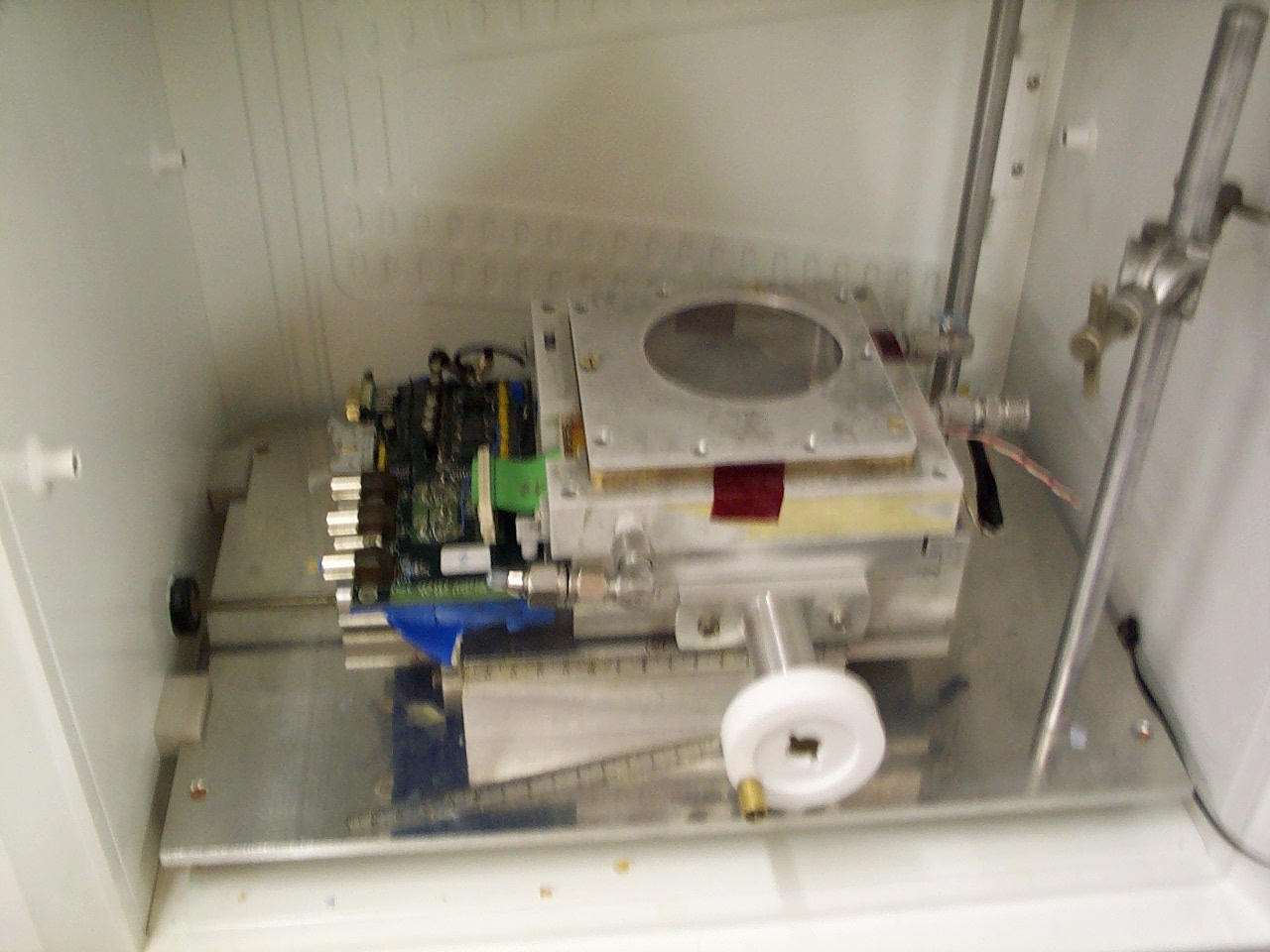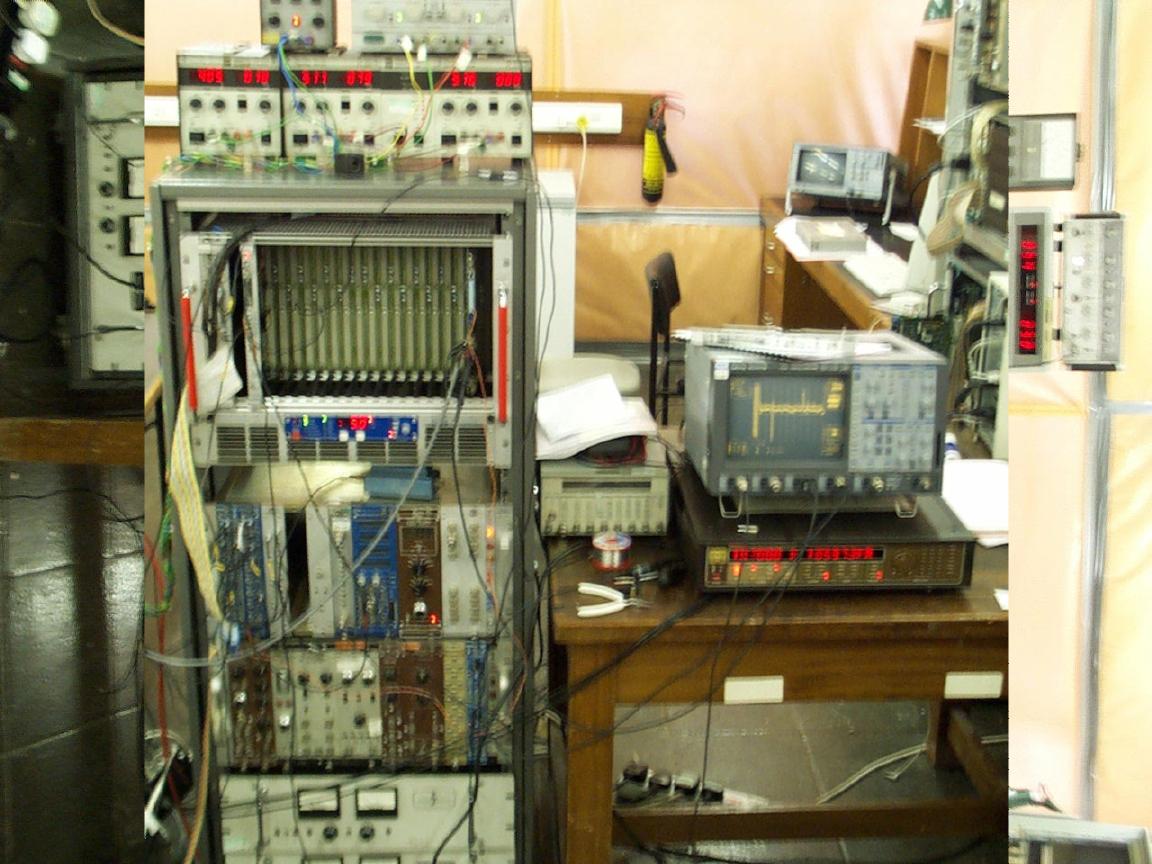Welcome to Gianluigi Casse’s home page
|
Here you can find summarised part of the silicon detector activity in the Physics Department of the University of Liverpool. You can also look to my personal page, by clicking
here. |
|
|
Silicon detector studies |
|
Experiments I am
involved
Atlas, LHCb, RD50. Some of the work I have performed in the framework of these experiments can be found below.
Radiation tolerance of silicon detectors
|
The silicon detectors will provide the main tracking capability for the future experiments in high-energy physics. In most of these experiments they will have to withstand a harsh radiation environment. The survival of the detectors to the severe radiation fluences they will receive is a challenge for the detector technology. We are involved in the development of the sensors for several of the major experiments that will take place in CERN-LHC (ATLAS, LHCb) and FERMILAB (CDF). In this page I have collected several results concerning the study of silicon detectors mainly on the subject of their radiation hardness. |
|
|
Notes |
(*) Irradiations were
performed in November '98, with the 24 GeV/c CERN/PS proton beam. The
cumulated fluence is 3 1014 cm-2. |
|
Performances of Hamamatsu (Ham.) and Micron (Mic.) ATLAS wedge detectors before and after irradiation (*)
|
Reverse current
vs bias |
Backplane
capacitance vs bias |
Interstrip
capacitance |
Noise vs bias
for irradiated detectors |
|
Strip integrity |
Irradiated (*) MICRON 1732-1-1, 1732-2-2, 1733-2-1 |
Studies for CDF
|
Full
depletion voltage vs operation time at various temperature Currents for
operations at various temperature (fluence in neutron cm-2): Strip current (strip width = 50
micron, length = 15 cm, detector thickness = 300 micron) |
Oxygen enrichment technique
|
I've conceived the high temperature
diffusion technique to introduce high concentrations of oxygen into silicon
wafers. This development was done in the frame of RD48 collaboration. It can
be used for other fast diffusing element in silicon. You find here the description of this technique. |
Results with oxygenated diodes .....
· Pad (5X5 mm2) diodes produced by SINTEF with oxygen diffused silicon. Silicon wafers coated with a layer of SiO2 were diffused in N2 or O2 atmosphere for 60 hours at 1150 oC. The diodes were irradiated, together with a standard reference sample, in April '99, up to 3 1014 cm-2 with the 24 GeV/c CERN/PS proton beam, in successive steps of intermediate fluences. They were annealed for 3 minutes @ 80 oC to complete the beneficial annealing before the measurement. The results are in term of full depletion voltage vs fluence and reverse current vs fluence.
· Pad (5X5 mm2) diodes produced by Brookeven National Laboratory (BNL) with oxygen diffused silicon. Silicon wafers coated with a layer of SiO2 were diffused in N2 atmosphere for 9 days at 1200 oC. Non oxygenated diodes from similar but non oxygenated wafer are used as a reference. The diodes were irradiated in July '99, up to 8 1014 cm-2 with the 24 GeV/c CERN/PS proton beam, in successive steps of intermediate fluences. They were annealed for 3 minutes @ 80 oC to complete the beneficial annealing before the measurement. The results are in term of full depletion voltage vs fluence.
· Pad (10X10 mm2) diodes produced by Micron Semiconductor with oxygen diffused silicon. Silicon wafers coated with a layer of SiO2 and wafers with surface implantation of oxygen ions were diffused in N2 atmosphere for 60 hours at 1100 oC. Non oxygenated diodes from similar but non oxygenated wafer are used as a reference. The diodes were irradiated in July '99, up to 4 1014 cm-2 with the 24 GeV/c CERN/PS proton beam, in successive steps of intermediate fluences. They were annealed for 3 minutes @ 80 oC to complete the beneficial annealing before the measurement. The results are in term of full depletion voltage vs fluence.
· The charge collection properties of oxygenated and control (standard) diodes are compared before irradiation and after 1.7 1014 p cm-2 , 4.0 1014 p cm-2 and 8.0 1014 p cm-2 using various diodes from different producers. They were annealed for 3 minutes @ 80 oC to complete the beneficial annealing before the measurement.
and some more with large area detectors .....
|
Can the oxygenation technique be used for
the production of large area segmented detector? Firsts results with
microstrip detectors processed by MICRON on 4" <100> silicon
substrate oxygenated for 110 hours at 1100 oC. A standard silicon
detector is used for control. |
Irradiation period November '99 (****)
|
Full size barrel, wedge and miniature
detectors were irradiated in this irradiation run, both in the ATLAS cool-box
(under bias) and in the PS-shuttle. |
Results (march 2000) with oxygenated silicon vs control material
The charge collection efficiency (from MIP electrons) of large area wedge
detectors is here
presented for 300 micron thick oxygenated and control and 250 micron thick
standard material after 3 1014 cm-2 , normalised to the
pre-irradiation value of the charge collection. The normalisation has been obtained by comparing the peak
of the charge distribution for overdepleted (500 V) irradiated detectors to the
peak of the plateau of the CCE for the non-irradiated detector. This gives
about a 10% charge deficit after irradiation. The charge collected by the
oxygenated and non-oxygenated detectors after irradiation is about the same for
strong overdepletion. This measurements have been done with SCT128 analogue
electronics.
LHC-b and oxygenated silicon?
The oxygenated substrate could improve the tolerance of the LHC-b vertex
detectors. Experiments are under way in the Liverpool silicon lab, using the
SCT128 electronics to compare CCE in non-homogeneously irradiated detectors. A
possible scenario for this solution is here
discussed.
Here you find some preliminary results of charge
collection efficiency and noise for a
detector partially irradiate (in the innermost region) with 24 GeV/c protons to
3 1014 cm-2.
|
|
|
|
|
First Laboratory measurements on a LHCb-phi prototype detector.
A fine spot laser system has been set-up in Liverpool to allow the full
characterisation of microstrip detectors. The system is particularly suitable
to measure the properties of inhomogeneously irradiated detectors. The
inhomogeneous fluence received by silicon sensors during the operation is a
concern for the LHCb experiment. Here I put the first draft to resume the
results of the measurements on LHCb-phi type detector partially irradiated with
24 Gev/c protons: 14/03/2001 Results with a
partially irradiated LHCb-phi type detector.
P-type microstrip detectors (thanks to Moshe Hanlon)
The use of n-strips on p-type silicon for microstrip detectors can extend the
lifetime of irradiated devices because of the profile of the electric field.
Here I have collected the results with the first successful n-in-p prototypes.
|
|
Before irradiation: |
Results after
irradiation (**): |
|
And here is the first evidence (January 2001)of improvement in term of the most relevant performance of particle detectors: the Charge Collection Efficiency (CCE) of an irradiated n-in-p is compared with the CCE of a standard and an oxygen-enriched p-in-n detectors after 3 1014 protons cm-2. The noise performances as a function of bias for the same detector are here shown. The improvement of the CCE is entirely due to the geometry of the electric field in the n-in-p diode structure and NOT to a lower full depletion voltage. This latter is not improved using p-type bulk, as it is shown here after 3 1014 protons cm-2.
CERN RD50: Radiation hard semiconductor devices for very high luminosity colliders
I am the convener of the Full Detector Systems research line of the CERN-RD50 collaboration. To see the scope and the participant institutes to this collaboration click here. I list some of the contribution I gave to the RD50 meetings and workshops:
5th RD50 workshop, Florence, 14-17 October 2004 – Talk
4th RD50 workshop, CERN 5-7 May 2002 – Talk
2nd RD50 workshop, CERN 18-20 May 2003 – Talk
1st RD50 workshop, CERN 2-4 October 2002 – Talk
RECENT PUBLICATIONS AND TALKS
Some of this material has been put together for conference presentations and/or
articles. Here I list some recent presentations.
|
|
|
|
RESMDD'04 |
…or the 5th International Conference on Radiation Effects on Semiconductor Materials Detectors and Devices October 10-13, 2004, L.go E. Fermi 2, Florence, Italy You find here the talk and the article. |
|
VCI
2004 |
…or the 10th Vienna Conference on Instrumentation, Vienna, Austria, February 16-21 2004 You find here the poster and the article. |
|
ERICE
2003 |
…or the workshop on Innovative Detectors for Supercolliders, Erice (TP), Italy, 29th Sep.-03 Oct. 2003 You find here the talk and the article. |
|
ELBA
2003 |
…or the 9th Pisa Meeting on Advanced Detectors, La Biodola, Isola d'Elba, 25-31 May 2003 November 3-8, 2002. You find here the poster and the article. |
|
VERTEX
2002 |
…or the 11th INTERNATIONAL WORKSHOP ON VERTEX DETECTORS, Ohana Keauhou Beach Resort, 78-6740 Alii Drive Kailua-Kona, Hawaii November 3-8, 2002. You find here the talk and the article. |
|
ELMAU
2002 |
… or the 9th EUROPEAN SYMPOSIUM ON SEMICONDUCTOR DETECTORS, New Developments on Radiation Detectors, Schloss Elmau, June 23 - 27, 2002. You find here the article. |
|
ISM2E-YS |
... invited talk at the International Symposium of Young Scholars on Mechanical and Material Engineering for Science and Experiments, 11-16th of August 2001 Changsha, Hunan Province, China. Here you can find the transparencies of my talk. |
|
4th STD |
... or the 4th International Symposium on Development and Application of Semiconductor Tracking Detectors (Hiroshima, March 22-25 2000). I have presented a comparative study of oxygenated and control Si diodes, miniature and full-sized microstrip detectors. Here you can find the transparencies of my talk. |
|
RD 99 |
... or the 4th International Conference
on Large Scale Applications and Radiation Hardness of Semiconductor Detectors
(Firenze, Italy, 23-25 June 1999) I have presented some results concerning
changes in interstrip capacitance and noise in microstrip detectors made by
Micron on 6" <100> substrate or by Hamamatsu on 4"
<111> substrate. |
|
Radecs 99 |
....or the 5th EUROPEAN CONFERENCE:
Radiation and its effects on components and systems (Abbaye de Fontevraud,
FRANCE, Maine et Loire, 13 - 17 septembre 1999). |
If you want to take a look to my thesis
(again on silicon detectors)
![]() PhD thesis (Université Joseph Fourier - Grenoble I,
France):
PhD thesis (Université Joseph Fourier - Grenoble I,
France):
The effect
of hadron irradiation on the electrical properties of particle detectors made
from various silicon materials.
N.B. Text is in English.
My ![]() Publication List.
Publication List.
Contact Information
|
|
|
|
|
|
Last modified: 01/05/03

